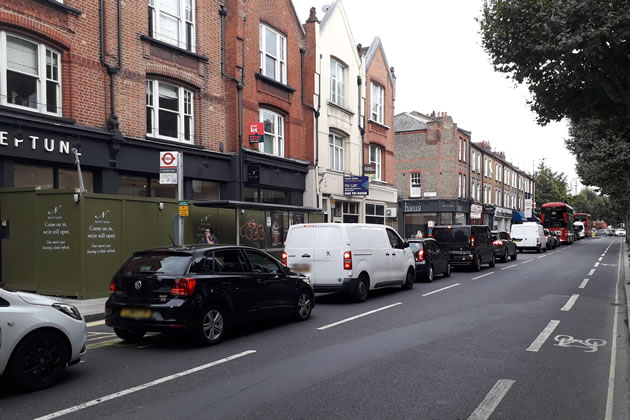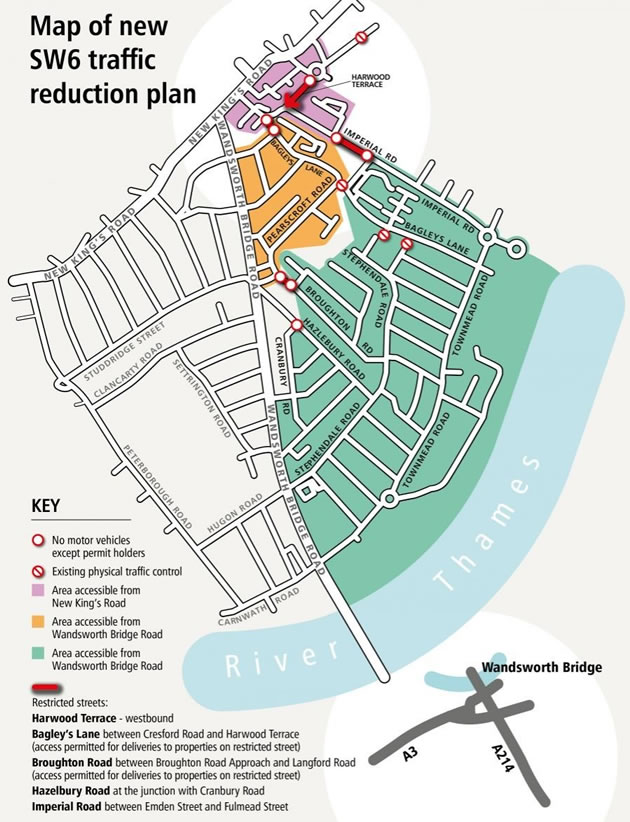Call for Changes To South Fulham Traffic Scheme
Residents claim Wandsworth Bridge Road constantly at a standstill

Council figures show traffic has reduced on Wandsworth Bridge Road
South Fulham residents are calling on council bosses to modify a divisive low-traffic neighbourhood system that has been in place for over six months.
The issue of traffic management has gripped Sands End for over a year, but took off when Hammersmith and Fulham Council’s Traffic Reduction Scheme was introduced in streets to the east of Wandsworth Bridge Road.
Under the scheme, number plate-recognition cameras were installed in the middle of certain residential streets in a bid to catch motorists who used them as rat runs.
Those caught by the cameras, and who don’t have permission to enter the area, can expect a £65 fine in the post.
The council launched the scheme in August, hoping it would deter non-residents from trying to cut through streets along Wandsworth Bridge Road (WBR).
It has proved popular for some, but not for hundreds of people and businesses along WBR itself, who say they have endured months of wall-to-wall traffic and increased air pollution.
The council has released traffic data, taken from September 2019 and September 2020, which suggests 5-15 per cent fewer cars are now using WBR.
More impressively, Bagleys Lane and Imperial Road saw reductions of over 70 per cent.
One WBR resident campaigning for the council’s scheme to be altered is Gary Fannin. He founded the Wandsworth Bridge Road Association last year, which now boasts 250 members.

Gary Fannin
“There’s standstill traffic along Wandsworth Bridge Road all day long,” said 51-year-old Mr Fannin.
“But the council keep saying their data has shown a drop in traffic along WBR, as if that’s enough.”
Now, he says fellow WBR residents are calling on the council to dramatically alter the scheme so that through traffic will be split between WBR and Imperial Road (linked by Townmead Road) to the east.
Maps and diagrams produced by the Association show how measures could be put in place to encourage:
- Northbound through-traffic to only use WBR
- Southbound traffic in WBR to be limited to vehicles permitted under the council’s scheme
- Southbound through-traffic to only use Imperial Road and Townmead Road
- Northbound traffic in Imperial Road and Townmead Road to be limited to vehicles permitted under the council’s scheme
The Association also proposes using “taps” to control the amount of southbound traffic that could access Imperial Road and Townmead Road. Similar to the council’s own proposals for WBR, this would involve introducing a no-right-hand turn onto Bagley’s Lane from New Kings Road. This could limit traffic on Imperial Road to 250 vehicles per hour, the Association says, which would meet the council’s objectives of reduced capacity.
Mr Fannin said, “This would mean we [WBR] would share the burden.
“We keep arguing that sharing traffic down Imperial Road, where much of it is just a building site, would be much fairer.
“We think it would agree with the council’s objectives of reducing pollution and congestion.”
Many Sands End residents have argued that “displacing” traffic will not solve the area’s problems, which have also been affected by the closure of Hammersmith Bridge and maintenance on Wandsworth Bridge last year.

Chris Cary, 68, of Townmead Road, was highly critical of the WBR Association’s proposal.
“If you’re opening up Imperial Road to southbound traffic then you’re opening up Townmead Road as well, which would never work,” he said.
“There’s thousands of apartments being built in the Gas Works development which are all going to have to be serviced.
“We [Townmead residents] are trying to get ourselves organised as well. There’s people all over South Fulham who see the solutions totally differently.
Mr Cary, who owns a bakery in Putney, added: “I sympathise with the desires of WBR residents, but theirs is the main arterial road… I don’t think moving the traffic around is the solution.”
The council said it has discussed the proposals with the Association, but believes, from its traffic data, that the Imperial Road proposal would “significantly increase” traffic levels.
“The data suggests traffic would increase by 28 per cent across the area while causing huge congestion in Townmead Road and failing to alleviate the congestion issue in Wandsworth Bridge Road,” a spokesperson said.
“This is because the southbound route junctions allow 700 vehicles per hour to enter but only 280 to exit via Townmead Road – a narrow residential street at its approach to Wandsworth Bridge.”

The council added that this could risk creating more rat runs.
Throughout the scheme, Hammersmith and Fulham Council has been consulting with residents via three separate working parties of 20-30 people, chaired by councillor Ben Coleman.
The three parties are split up to represent: residents on the east side of Wandsworth Bridge Road; residents and businesses along Wandsworth Bridge Road; and residents to the west of it.
The council has also been making plans for a separate traffic-reduction scheme for streets to the west of WBR – which have also had complaints about congestion – by using a new set of number plate-recognition cameras. It hopes that closing these rat runs will reduce road-user demand for WBR even more.
A spokesperson said: “Published data shows pollution is half what it was in 2017/2018 prior to the introduction of the [traffic reduction scheme]. We are currently installing a groundbreaking, state of the art micro level air quality monitoring network to further monitor pollution.”
For more information about the SW6 traffic scheme, visit the council’s website.
Owen Sheppard - Local Democracy Reporter
February 17, 2021